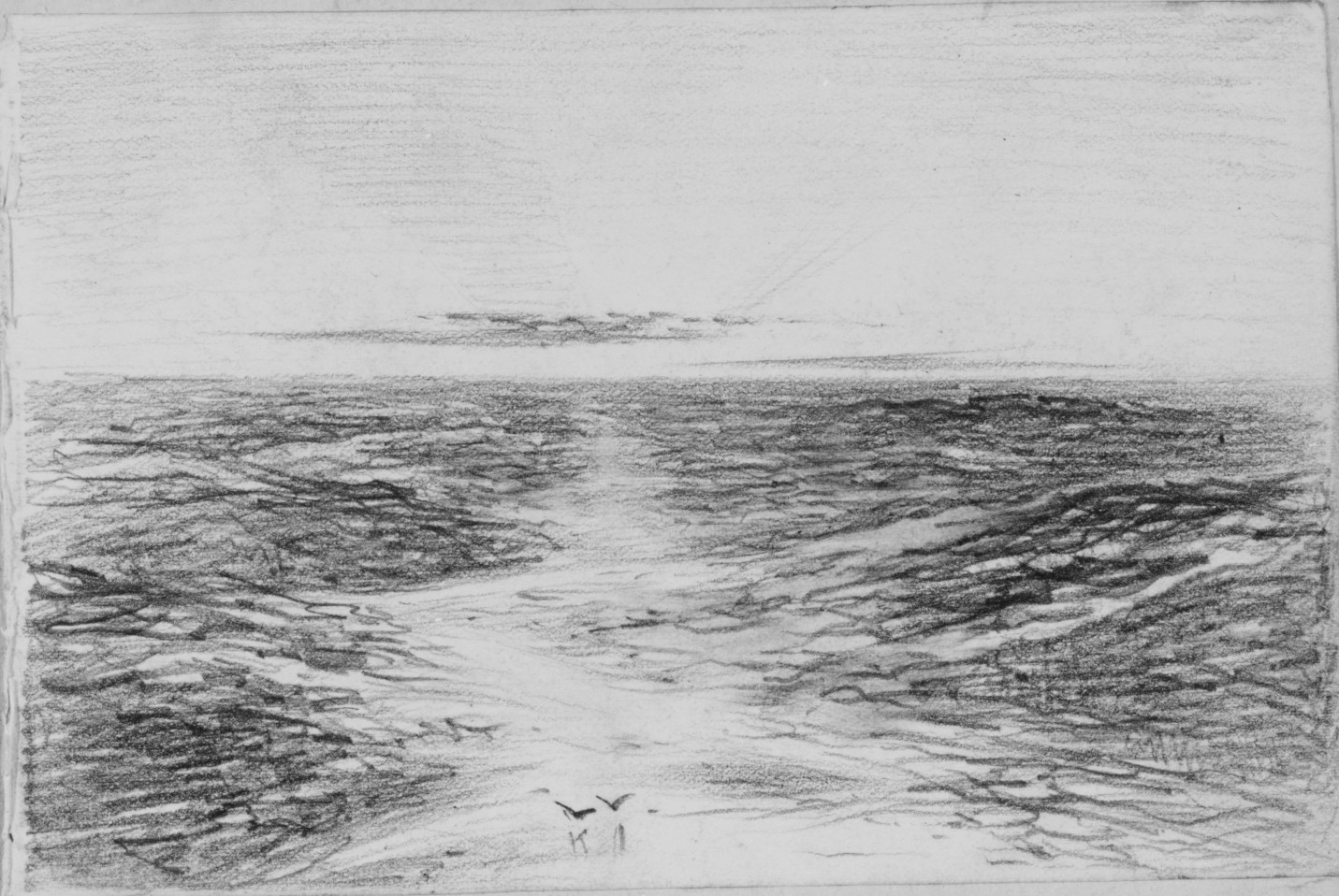CFA Issue 24: On Water: The Aqueous in Architecture
CALL FOR ABSTRACTS
Interstices: Journal of Architecture and Related Arts – Issue 24
On Water: The Aqueous in Architecture

John Singer Sargent, “Moonlight On Waves” (circa 1876) [Graphite on off-white paper. Source: Wikimedia Commons, image gifted by Mrs Francis Ormond, 1950]
On Water: The Aqueous in Architecture
For us humans, the flow and flush of waters sustain our own bodies, but also connect them to other bodies, to other worlds beyond our human selves. Indeed, bodies of water undo the idea that bodies are necessarily or only human.
Astrida Neimanis (2016)[1]
Tell me what infinity attracts you, and I will know the meaning of your world. Is it the infinity of the sea, or the sky, or the depths of the earth, or the one found in the pyre.
Gaston Bachelard (2011)[2]
Water makes its presence felt, and increasingly so. It emerges from our mouths in vaporous clouds, bulges as the moon encircles the earth, and inundates cities. Water’s actions and its flowing intelligence are the focus of Issue 24 of Interstices: Journal of Architecture and Related Arts.
We call for work that extends contemporary, historical, and cross-cultural understandings of the aqueous in architecture. Our scope is broad in scale from the atmospheric and the planetary, to the scale of the body, blood, cells, to infinitesimal waves shimmering in subatomic worlds. We are interested in water’s aleatory effects on architecture and its potential to prompt ideas at the edge of its substantialist comprehension. Proposals are sought for writing on water’s metaphorical force, its schlieren image-like dynamics, its creative co-agency—as material entity and legal person—its ‘view,’ in other words on how architecture might be formed, thought about, created, or occupied by the elemental force of water.
We invite abstracts describing paper and creative practice proposals that will focus on the critical and immediate of water: as a resource; as an element capable of determining global futures; as a figure for grasping global economics (at the level of ‘liquidly’ and capital flows, themselves integral to architectural production); as a trope for modern societal formations (via Zygmunt Bauman’s notion of ‘liquid modernity’); with the ocean’s vast infrastructural and organizational remaking (as recognized by Nancy Couling and Carola Hein in The Urbanisation of the Sea); as an element indicative of human evolutionary factors (via say, Mark and Dianna McMenamin’s, Hypersea: Life on Land); and as a focus for drawing on posthuman and gender-critical inquiry (for example, Astrida Neimanis’, Bodies of Water: Posthuman Feminist Phenomenology).
Water is rich and multifaceted, but relates particularly to the geographic, geologic, and cultural specificity of Aotearoa New Zealand. This is particularly so given recent understandings of Zealandia as a largely submerged ancient ‘supercontinent’, for which the landmass of Aotearoa is but a modest series of ridges emerging from the sea. In this issue we further emphasise both the broadly global implications of the aqueous in architecture and spatial production, and also place-specific dimensions with the arising and maintaining of cultural and creative life in the South Pacific (as, for example, suggested by Damon Salesa in An Indigenous Ocean (2013)).
Contributors are invited to submit papers centred by theoretical and critical reflection on the call thematic or that critically document creative works aligned with it.
Topics may include, but are not limited to:
- Spaces, sites, and practices that focus on water and its care, retention, extraction, or industrialisation;
- Indigenous perspectives on water management and kaitiakitanga;
- Currents of non-human agency: geological, oceanic, glacial, and hydrological;
- Historical/cultural narratives;
- Architectures of water storage, reticulation, treatment, leisure, and recreation;
- Critiques of the Anthropocene and broader considerations of water’s material agency and imaginability; and
- Creative practices and drawing approaches that participate in watery agency.
We invite abstracts (800 words in length) describing a full paper yet to be developed (6,000 words maximum), plus a bio-note (80-100 words) for the forthcoming “On Water” issue of Interstices: Journal of Architecture and Related Arts. Please submit your abstract in Chicago format and omit identifying details in the main manuscript.
For full publishing options and formatting details, please refer to the Guidelines for Submissions at: https://interstices.ac.nz/index.php/Interstices/information_for_contributors.
For additional queries contact Andrew Douglas at – andrew.douglas@auckland.ac.nz.
Estimated Timeline:
- Release of CFA: Friday 21 June 2024
- Call for Postgraduate Creative Design Projects: Monday 1 July 2024
- Submission of abstracts for peer-reviewed papers: Friday 19 July 2024
- Abstract Acceptance Notification: Friday 23 August 2024
- Submission of Postgraduate Creative Design Projects (PCDP): Friday 16 August 2024
- Completion of peer review of PCDP & author notification: Friday 13 September 2024
- Submission of full papers: Friday 18 October 2024
- Review of full papers by: Friday 20 December 2024
- Revised papers to be returned by: 21 February 2025
- Issue publication: 28 March 2025
Issue Editors:
Simon Twose – Te Herenga Waka, Victoria University of Wellington
Jeanette Budgett – Te Whare Wānanga o Wairaka, Unitec
Andrew Douglas – Waipapa Taumata Rau, University of Auckland
Executive Editors:
Andrew Douglas – Waipapa Taumata Rau, University of Auckland
Susan Hedges – Te Wānanga Aronui o Tāmaki Makaurau Rau, Auckland University of Technology
Julia Gatley – Waipapa Taumata Rau, University of Auckland
[1] Astrida Neimanis, Bodies of Water: Posthuman Feminist Phenomenology (London, UK: Bloomsbury, 2016), 2.
[2] Gaston Bachelard, Air and Dreams, trans. Edith Farrell (Dallas, TX: Dallas Institute of Publishing, 2011).

